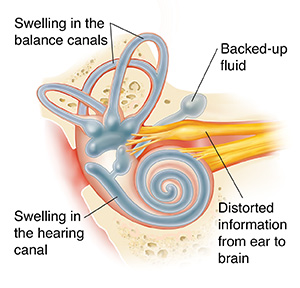What Is Meniere's Disease?
What Is Meniere’s Disease?
Meniere’s disease is a problem with the inner ear. This part of the ear is responsible for balance as well as hearing. This sheet will tell you more about the disease and its symptoms.
Meniere’s disease affects the inner ear
With Meniere’s, too much endolymph (fluid) backs up in the canals of the inner ear. This is a condition called endolymphatic hydrops. Extra fluid causes pressure to build up. The canals then swell and can’t work right. Swelling in the hearing canal distorts or blocks sound information. Swelling in the balance canals distorts balance information. Distorted information travels from the inner ear to the brain. This causes problems with both balance and hearing. Although Meniere’s usually affects only one ear, it can occur in both ears.
Symptoms of Meniere’s disease
Vertigo, a spinning or whirling sensation that causes balance problems. During an attack of vertigo, you may have nausea, vomiting, and sweating. Attacks usually begin suddenly. They may last for 20 minutes to several hours. You may have attacks rarely, frequently, or in clusters. The first attack is usually the most intense.
Problems with hearing. Hearing is often partially or completely lost in the affected ear during vertigo attacks. It’s common for hearing to gradually get worse as the illness goes on.
Tinnitus, ringing, buzzing, whistling, or roaring noises in the affected ear. These noises may come and go or may always be present. The noises may get louder just before a vertigo attack.
A feeling of pressure or fullness in the ear. This is sometimes felt most strongly right before a vertigo attack.
You may feel fine between attacks. Or hearing or balance problems may continue between attacks.
Updated:
October 09, 2017
Reviewed By:
Fraser, Marianne, MSN, RN,Image reviewed by StayWell medical illustration team.,Kacker, Ashutosh, MD
